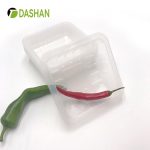Roast Chicken Packaging is driving supermarket and takeaway sales worldwide by keeping food hot, fresh, and visually appealing. With recyclable PP bases and anti-fog lids, disposable roast chicken boxes ensure safe transport, strong branding, and eco-friendly convenience for global food retailers.
Introduction
Few foods trigger the same instant craving as the aroma of a freshly roasted chicken. Yet behind every golden-brown rotisserie bird lies an unsung hero—its packaging. Far from being just a container, roast chicken boxes now play a vital role in food safety, shelf appeal, transportation, and even sustainability.
In this blog, we’ll explore the global demand for roast chicken packaging, why supermarkets and foodservice businesses are upgrading to disposable roast chicken boxes, how different countries are adopting them, and what the future holds for this essential part of the poultry industry.
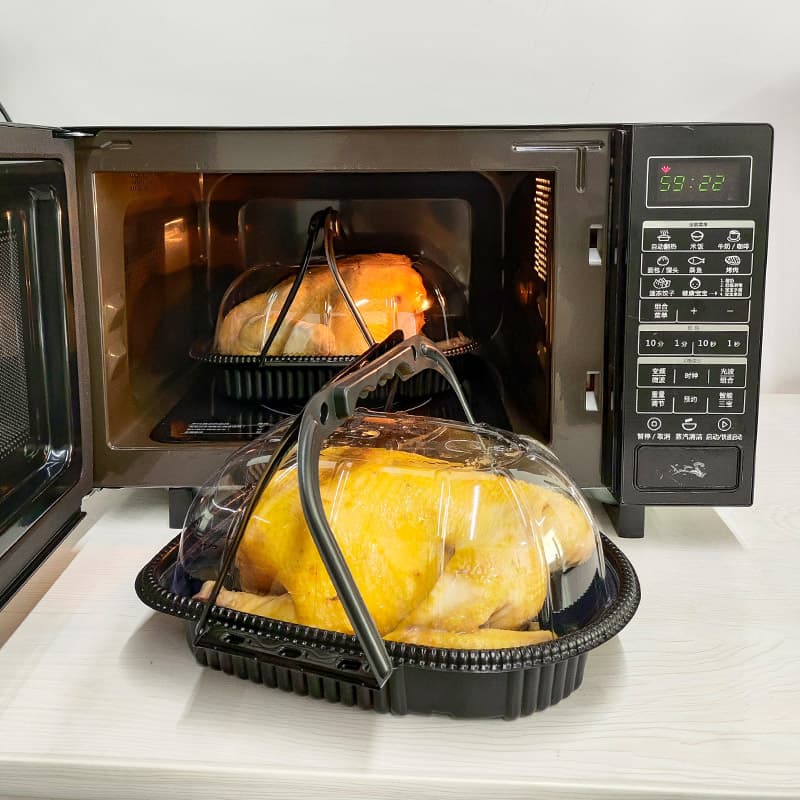
Why the Market for Roast Chicken Boxes Is Booming
Poultry Packaging Industry Growth
The demand for roast chicken packaging is closely tied to the booming poultry market.
-
The global poultry packaging market was valued at around USD 3.65 billion in 2025 and is projected to reach USD 4.59 billion by 2030, growing at a CAGR of 4.69%.
-
By 2032, it is expected to surpass USD 6.5 billion, with North America holding over 32% of the market share.
-
Within this sector, ready-to-eat poultry packaging (rotisserie chickens, grilled poultry, hot deli foods) is the fastest-growing category.
This growth is fueled by consumer preference for convenience, freshness, and attractive food presentation.
Changing Consumer Habits
-
Rotisserie chicken is one of the most popular ready-to-eat meals worldwide.
-
Consumers want packaging that is microwave-safe, leak-proof, easy to carry, and recyclable.
-
Anti-fog transparent lids are especially important for visual appeal—nobody wants their roast chicken hidden under a foggy plastic dome.
-
Sustainability has become a purchase driver, with both retailers and customers demanding recyclable or reduced-plastic options.
International Case Studies
United States
-
Americans consume over 800 million rotisserie chickens annually, with annual growth far outpacing raw poultry sales.
-
Retail giants like Costco alone sell over 100 million rotisserie chickens every year. Traditionally, these were packaged in sturdy PP base trays with clear OPS lids.
-
In 2024, Costco experimented with switching to plastic bags with handles to reduce plastic usage. The move sparked customer complaints, since bags were less sturdy and less appealing compared to clear-lidded boxes. This case highlights the tension between sustainability and consumer experience.
Europe
-
European retailers emphasize food safety and environmental compliance. Many supermarkets use PP/OPS containers with clear lids, while others experiment with paperboard boxes with plastic windows to reduce plastic usage.
-
EU packaging laws push companies toward recyclable and reduced single-use plastics. As a result, innovation in eco-friendly roast chicken packaging is accelerating.
Asia-Pacific
-
In China and across East Asia, roast chicken, braised chicken, and grilled poultry are increasingly popular in supermarkets and convenience stores.
-
The demand for anti-fog lids, grease resistance, and stackable packaging is high due to strong takeout and delivery culture.
-
Government regulations around food safety and recycling are gradually shaping packaging standards.
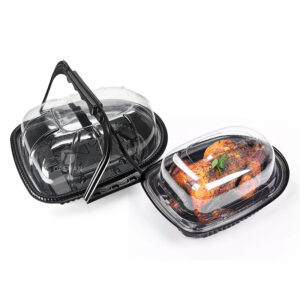
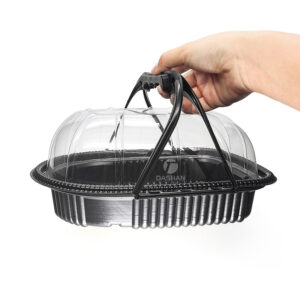
Sales Impact and Business Insights
Although specific “roast chicken box” sales numbers aren’t public, market behavior makes the scale clear:
-
If Costco alone sells 100+ million chickens annually, packaging demand for roast chicken containers runs into the hundreds of millions of units each year.
-
Every major supermarket chain that sells rotisserie chicken relies on sturdy disposable chicken boxes—making them one of the most widely used hot food packaging types worldwide.
-
Packaging upgrades (from plastic bags to transparent anti-fog boxes) can directly impact sales by improving product visibility, shelf life, and consumer satisfaction.
Applications & Challenges
| Application | Benefits | Challenges |
|---|---|---|
| Supermarkets & Deli Counters | Strong visual appeal, easy stacking, impulse-buy driver | Must resist fogging, leaks, and maintain stability during transport |
| Takeaway & Delivery | Keeps food hot and intact, portable | Requires leak-proof seals, durable handles, sustainable design |
| Catering & Events | Bulk service efficiency, professional look | Need strong lock systems and customizable branding |
| Rotisserie Shops | Showcases signature products in style | Packaging must balance cost with high-quality presentation |
Packaging Technology Trends
-
Material Evolution: PP bases paired with OPS anti-fog lids are industry standards for balancing heat resistance, clarity, and safety.
-
Anti-Fog Coatings: Prevent steam buildup and ensure clear display.
-
Handle & Lock Designs: Enhance portability and leak resistance.
-
Eco-Friendly Materials: Recyclable PP, lightweight plastics, and bio-based options are gaining traction.
-
Smart Branding: Printed logos, QR codes, and custom designs turn packaging into a marketing asset.
Competitive Advantage Through Customization
In crowded supermarket aisles, packaging is often the silent salesperson. That’s why leading manufacturers now offer:
-
Logo printing for brand recognition
-
Color and size options to match portion sizes
-
Special lid designs (handles, locks, reinforced anti-fog lids)
-
Bulk supply for wholesalers and chains
This customization transforms a simple roast chicken box into a branding tool and customer experience enhancer.
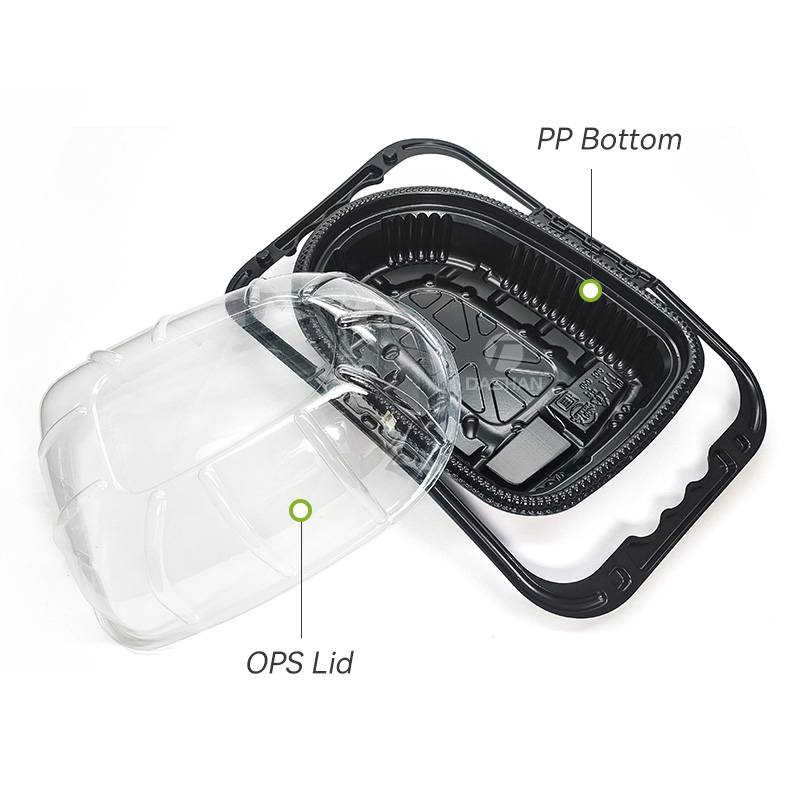
Frequently Asked Questions
Q1: Are disposable roast chicken boxes microwave-safe?
Yes, the PP base is microwave-safe, but the OPS lid should be removed before reheating.
Q2: Can they be recycled?
Yes, both the PP base and OPS lid are recyclable, supporting eco-friendly practices.
Q3: Do supermarkets prefer boxes with handles?
It depends—handles improve portability, but no-handle designs are cheaper and easier to stack. Retailers often stock both.
Q4: How do they affect sales?
Clear, anti-fog lids increase product visibility, which directly boosts impulse buys in supermarkets.
Conclusion
The disposable roast chicken box is more than a container—it’s a strategic tool for food businesses. It ensures food safety, improves presentation, supports branding, and enhances customer convenience.
From the U.S. to Europe to Asia, demand for rotisserie chicken packaging continues to rise. With consumers expecting freshness, sustainability, and visual appeal, supermarkets and foodservice providers must choose packaging that delivers reliability and reinforces brand trust.
At Xiamen Dashan®, we design and manufacture professional food packaging solutions including PP and PET boxes, eco-friendly trays, and customizable options for global distributors. Whether you need a supermarket-ready roast chicken container, a delivery-friendly takeaway box, or a branded packaging solution, our products combine performance, safety, and sustainability to help your business thrive.
References
-
Statista – Global rotisserie chicken market size:
https://www.statista.com/statistics/rotisserie-chicken-market -
Costco Rotisserie Chicken Sales Report (2023):
https://www.cnbc.com/2023/11/20/costco-rotisserie-chicken-sales -
Tesco Hot Food Packaging Insights:
https://www.tesco.com/groceries/en-GB/zone/food-to-go -
Packaging Europe – Anti-fog food packaging demand:
https://www.packagingeurope.com/anti-fog-packaging-trends


